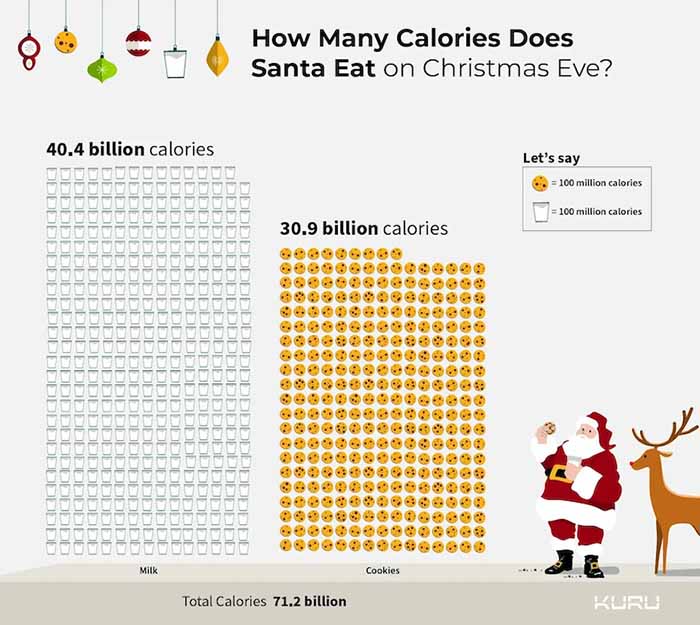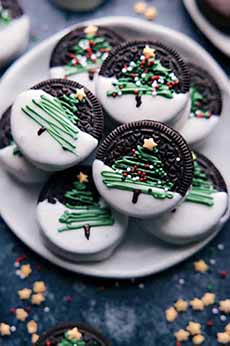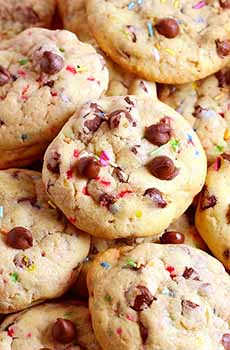How Many Calories Does Santa Consume on Christmas Eve?
|
|
Why is Santa Claus so chubby? Because every Christmas eve, he eats plate after plate of cookies with glasses of milk left out by boys and girls the world over. Every Christmas Eve, Santa has the seemingly insurmountable task to not only deliver children’s gifts worldwide—but to consume their cookies and milk, too, says Kuru Footwear. All of Saint Nick’s hard work certainly deserves some refreshments, but just how many calories are we talking? Kuru crunched the cookie calculations and found that since Santa visits a whopping 395,830,485 homes, he’ll consume 71.2 billion calories from milk and cookies on Christmas Eve. Keep reading for a calorie breakdown, Santa’s holiday weight gain, and how far he’d have to tread to walk it all off. (Maybe that’s how he spends the other 364 nights of the year: walking!) Kuru drilled down into what takes place across the globe in a single night. > The history of the tradition is below. > Also below, what children in other countries leave for Santa Claus. 🎅 After visiting upwards of 395 million homes, Santa consumes a staggering 71.2 billion calories on Christmas Eve alone.
More than half of those calories (40.4 billion) come from whole milk, and one cookie at each home adds another 30.9 billion calories. 🎄 If Santa were to gain weight from all those Christmas treats, he’d be looking at a potential gain of 20.4 million pounds. It seems the reindeer have some heavy lifting to do. 🍪 To burn off those festive calories, Santa would need to embark on an epic journey of 503 million miles. That’s the equivalent of walking around the Earth more than 20,000 times! That’s some New Year’s resolution. What about the reindeer? 🦌 It’s not just Santa who gets a treat. Each of the nine reindeer could be chomping down on more than 44,000 carrots, totaling a whopping 2.3 billion calories. Of course, they’ll work a lot of that off pulling the heavy sleigh all over the globe. We need to go all the way to ancient Norse mythology. Odin, the most important Norse god, had an eight-legged horse named Sleipner, which he rode with a raven perched on each shoulder. During the holiday season, children would leave food for Sleipner, in the hopes that Odin would stop by and leave gifts in return. This tradition continues today in Belgium, Denmark, and the Netherlands, where children still believe that horses, not reindeer, pull Santa’s sleigh. On Christmas Eve, children leave carrots and hay—sometimes stuffed into shoes—to feed the exhausted horses. In return, Santa might leave such treats as chocolate coins, cocoa, mandarin oranges and marzipan. In the U.S., leaving a plate of cookies and a glass of milk for Santa Claus is the Christmas Eve tradition. Oreos and chocolate chip are popular choices. According to one theory, the cookies-and-milk custom derives from an older tradition, when families would stuff stockings with goodies for Santa and hang them by the chimney as a welcoming gift. Now, however, the tradition is reversed: the stockings are chock-full of treats and smaller gifts for the family members themselves. (Who ended up eating all of the goodies originally provided for Santa?) Leaving cookies and milk for Santa—and thoughtfully, a few carrots for his reindeer—emerged as an American holiday tradition in the 1930s, during the Great Depression, a time of great economic hardship*. Many parents tried to teach their children that it was important to give to others and to show gratitude for the gifts they were lucky enough to receive on Christmas. Some 80 years later, many children still set out cookies and milk for Santa, whether out of the goodness of their hearts or as a bribe to receive more gifts Santa. Countries across the globe have their own versions of the popular Christmas tradition. If you could create one especially for your family, what would it be? Over the years, different countries have developed their own versions of the cookies-and-milk tradition. According to History: |
|
|
________________ *The Great Depression was the worst economic period in history. In the United States, unemployment rose to 25% at its highest level during the Great Depression. Literally, a quarter of the country’s workforce was jobless. This number translated to 15 million unemployed Americans in 1933 [source].  [7] The calorie count: overwhelming (photo © Kuru Footwear). CHECK OUT WHAT’S HAPPENING ON OUR HOME PAGE, THENIBBLE.COM.
|
||









